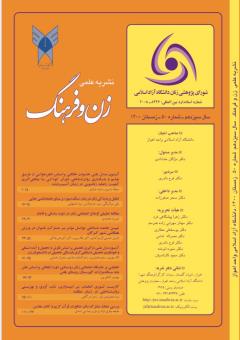بررسی صفات مشترک زنان صالح در قرآن کریم و کتاب مقدس
محورهای موضوعی : اخلاق
ملیحه باقری نژاد یزدی
1
![]() ,
رضا بنی اسدی
2
*
,
رضا بنی اسدی
2
*
1 - حوزه علمیه خواهران امام حسین (ع) یزد، گروه تفسیر قرآن کریم، یزد، ایران.
2 - دانشگاه علوم پزشکی شهید صدوقی یزد، گروه معارف اسلامی، یزد، ایران.
کلید واژه: صفات زنان صالح, کتاب مقدس, قرآن کریم,
چکیده مقاله :
هدف از پژوهش حاضر تبیین صفات مشترک زنان صالحه در قرآن کریم و کتاب مقدس است. جامعه مورد بررسی آیات قرآن کریم و کتاب مقدس میباشد. نمونه پژوهش آیات الهی قرآن کریم و کتاب مقدس در رابطه با صفات مشترک زنان صالحه در قرآن کریم و کتاب مقدس است. این پژوهش توصیفی تحلیلی بوده و اطلاعات از طریق اسنادی و کتابخانهای حاصل شده است. تحلیل با استفاده از دادههای به دست آمده از آیات قرآن کریم و کتاب مقدس صورت گرفته است. نتایج پژوهش نشانداد که در قرآن کریم و کتاب مقدس برای زنان صالحه در دو حوزه فردی و خانوادگی صفاتی بیان شده است. از منظر قرآن کریم و کتاب مقدس زنان صالحه در حوزه فردی دارای صفاتی مانند ایمان، عمل صالح، تقواپیشگی، پاکدامنی، راستگویی، حیا، حجاب، پرهیز از خودنمایی و چشم پاکی میباشند. همچنین در حوزه خانوادگی زنان صالحه را دارای صفاتی مانند شوهرداری، خانهداری و فرزندپروری معرفی شدهاند.
The purpose of this study was to explain the common characteristics of righteous women in the Holy Quran and the Bible. The understudied universe was the verses of the Holy Quran and the Bible. The sample of the research particularized the divine verses of the Holy Quran and the Bible in relation to the common attributes of righteous women in the Holy Quran and the Bible. This research was descriptive-analytical and the data was obtained through documents and libraries. The analysis was performed using the data obtained from Quranic verses and the Bible. The results of the present study indicated that in the Holy Quran and the Bible, attributes were expressed for competent women in both individual and family domains. According to the Holy Quran and the Bible, righteous women in the personal sphere have attributes such as faith, righteous deeds, piety, chastity, truthfulness, modesty, hijab, refraining from showing off and being none lascivious. Also in the family field, competent women were introduced with traits such as being nice in the life with husband, housekeeping and parenting.
The Holy Quran
Matthew Gospel
Old Testament
Afshar, L., & Rostami, Z. (2011). Characteristics of worthy women from the perspective of the Holy Quran. Quranic Studies, 2(5), 9-22. [Persian] URL: http://qsf.iranjournals.ir/article_629597_bd66bc5f8eb5ce2cfa2c27cb7b01e7ba.pdf
Ahmadi, M., & Hosseini Shahroudi, S. M., & Morvarid, J. (2021). Investigating the relationship between "faith" and "righteous deeds" with the focus on Quranic verses. Journal of Theology, 7(14),113-134. [Persian] URL: http://pke.journals.miu.ac.ir/article_5837_a1bf3c1127c2d238e3c4c25b36fc3240.pdf
Alikhani, R. (2010). Women in holy texts: women in Judaism. Tehran: Enlightenment and Women's Studies. [Persian] URL: https://www.gisoom.com/book/1732697/
Bakhtyiar, M., & Rezaee, A. (2012). Study of the status and position of women in Islam and Christianity. Women and Culture, 3(11), 61-73. [Persian] URL: http://jwc.iauahvaz.ac.ir/article_523297_a7da10d82681ab9176f3d6056bb8f8c8.pdf
Bokai M., & Enjazab, B. (2020). Marital lifestyle from the perspective of Islam. Article presented at the third national conference on lifestyle and health, Yazd, Iran. [Persian] URL: http://cnf.iauyazd.ac.ir/fa/article.php?lrId=59&cnfId=7
Chavoshiyan, M., & Nikoee, M. (2020). Study of the Status of Women in the Historical Periods of Christianity. Article presented at the Regional Conference on Applied Research in Humanities and Islamic Sciences, Gom, Iran. [Persian] URL: https://civilica.com/doc/1018557
Dashti Khoydaki, F., & Tabatabai, S. A., & Etemadi Fard, A. (2017). Women's duties in the family in imami jurisprudence. Article presented at the First National Conference on Social Sciences, Educational Sciences, Psychology and Social Security, Tehran, Iran. [Persian] URL: https://civilica.com/doc/672316
Farhadi, S., & Andalib, A. (2017). Hijab in the Quran and the Bible, International Journal of Multidisciplinary and Interreligious Pure Life, 1(8), 67-85. [Persian] URL: https://www.magiran.com/paper/1699272
Javadi Amoli, A. (2019). Woman in the mirror of glory and beauty. Qom: Esraa. [Persian] URL: https://library.tebyan.net/fa/Viewer/Text/61570/8#
Kamranian, A. (2009). Characteristics of Worthy Women in the Holy Quran. Qom: Noor Quran and Ahlul Bayt Publications. [Persian] URL: https://ahlolbait.com/files/download/12/3389-FA-vijegihaye-zanan-shayesteh-dar-quran-majid.pdf
Makarem Shirazi, N. (1992). Tafsir of Nemoneh. Tehran: Islamic Books House. [Persian] URL: https://lib.eshia.ir/27575/2/161
Moradi Khalaj, M. (2010). Righteous women in the Quran. Shiite Women, 7(23), 132-151. [Persian] URL: http://ensani.ir/file/download/article/20120614194814-9011-5.pdf
Najafi, Mohammad Hassa. (2001). Jawahar al-Kalam. Qom: Islamic Publishing Institute. [Persian] URL: http://lib.eshia.ir/10088/17/131
Oladi, Sh., & Jahanbakhsh, E., & Mohamadi, A. (2019). The effect of bad hijab and dressing on women's sense of personal security Case study: Women and girls over 15 years old in Tehran. Socio-disciplinary researches on women and the family, 7(1), 102-120. [Persian] URL: http://pssw.jrl.police.ir/article_91406_5e2ae9dca84ef924fb313c53e3b4b2d0.pdf
Panahi, A. (2016). A look at the benefits and effects of childbearing and parenting in religious teachings with a moral approach. Ethics, 6(21), 33-63. [Persian] URL: http://akhlagh.morsalat.ir/article_63976_f8a4fe7f994f02bc643e70acb2f860a1.pdf
Qaraati, M. (2009). Tafsir Noor. Tehran: Cultural Center for Lessons from the Quran. [Persian] URL: https://www.ghbook.ir/index.php?name=%D8%AA%D9%81%D8%B3%DB%8C%D8%B1%20%D9%86%D9%88%D8%B1&option=com_dbook&task=readonline&book_id=2665&page=1&chkhashk=18A0AD00E3&Itemid=218&lang=fa&tmpl=component
Riahi Dehkordi, P. (2018). A comparative study of female personality in the Holy Quran and the testaments. Article presented at the International Conference on Innovation and Research in Humanities, Management and Islamic Studies, Tehran, Iran. [Persian] URL: https://civilica.com/doc/800465
Sadati, E., & Naemati, D. (2015). The position of women in the West from the Bible to Descartes. Article presented at the Second International Congress of Religious Culture and Thought, Qom, Iran. [Persian] URL: https://civilica.com/doc/548243
Sakhaee, M. (2011). Finding the root of the women's crisis in the West by relying on biblical teachings. Strategic Studies of Women, 14(53), 247-274. [Persian] URL: http://www.jwss.ir/article_12241_c1c574fcbcc460de574602a5f6b75a00.pdf
Shakurinejad, E. (2014). Faith from the perspective of the Holy Quran and the New Testament. Esharat, 1(1), 106-122. [Persian] URL: http://ensani.ir/file/download/article/20141027110402-9965-6.pdf
Tabarsi, F. (1995). Tafsir of majma-albayan. Beirut: Al-Alamy Foundation for Publications. [Persian] URL: http://lib.eshia.ir/12023/1/2
Tabatabai, M. (1995). Tafsir of al-Mizan. Beirut: Al-Alamy Foundation for Publications. [Persian] URL:. [Persian] URL: https://archive.org/details/almizan_alami_22j//
_||_

